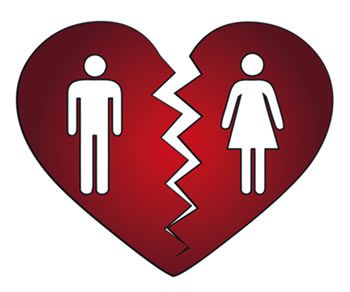The Question of Divorce and Remarriage
Why Not Dispensation?
Part 2
Unfortunately, for many married couples the ideal just does not happen! Breaches of the marriage covenant transpire and, just like breaches of divine covenants, are held to be sinful, demonstrating, as they do, an unwillingness of one or both parties to uphold God’s designs for creation. Often enough the breach is “one-sided” but still results in a fracturing of the marriage bond which can become difficult to heal.
“I will give you the keys of the kingdom of heaven, and whatever you bind on earth will be bound in heaven, and whatever you loose on earth will be loosed in heaven.”(Mt 16:19; cf Mt 18:18)
When a wound is bound up, the healing process can begin; when the bandage is loosened and removed, healing is complete even though some scarring may remain. Is not bandaging the wounds within marriages an essential function for the Church? After all, Jesus tells us that the only sin that cannot be forgiven is the sin against the Holy Spirit (cf Mk 3:29).
Couples can lose touch with the Church and live without making reference to God and his interaction with humans; then, when troubles occur, they adopt flawed Societal strategies. Some marriages are beset by sinfulness including instances of desertion, adultery, spousal violence (both physical and emotional) and violence toward children. Couples may stay together “for the sake of the children” or “because there is nothing else for me” all the while enduring deep suffering. Others become inured to their situation, virtually living a solitary existence to protect the marriage. Yet others decide to separate and these frequently divorce and often enough remarry. In all of these very human situations the fabric of both Church and society is seriously impaired.
For those who separate, their split may be either temporary or permanent. Counsellors with good skills can sometimes assist with the problems facing marriages and enable couples to resume their relationship. The Church needs to be active in this field, leading couples away from those so-called counsellors who do little more than provide guidance based on the supposition the couple are heading for divorce. Still, the Church’s response to any couple with marital problems must focus on their specific individual and particular needs.
Divorce is a civil acknowledgement of separation and disregards Catholic teaching of Indissolubility of Sacramental Marriage. What tends to be passed over is that divorce completes the break in the marriage covenant. If the covenant is broken has not the marriage failed? It appears then, that this is why divorce is accepted by most other Christian denominations as the termination of marriage. In New Zealand, society has adopted a strategy of “no fault” divorce which allows a couple to divorce after twelve months separation. The policy provides for joint responsibility in the raising of the children and equal shares in matrimonial property, however, such provisions do not always result in empathetic proceedings.
Some (1) maintain that divorce is innately sinful but soften their stance by proffering a number of caveats. In reality, a marriage breakdown involves matters of conscience and this must be a matter for individual resolution. All too frequently, an innocent party is left to pick up the pieces of his/her life and that of the children following divorce: this is where the question of innocence will still need to be addressed in any issues of rectification, annulment or dispensation.
Remarriage is held to be adultery even on the part of a non-divorced party to a divorced party in a civil marriage. Insofar as the Catholic(s) involved it is certainly precluded by the gospel teaching:
“Whoever divorces his wife and marries another commits adultery against her; and if she divorces her husband and marries another, she commits adultery.” (Mk 10:11-12)
The penalty imposed in the event of a civil remarriage, excommunication, is the same as that applied under the sins of apostasy or murder. Essentially the parties are deprived of access to the Sacrament of the Eucharist as well as Reconciliation and perhaps even Anointing of the Sick. After excommunication, priests may absolve for excommunication if the penitent is in danger of death. (2)
However, automatic imposition of the penalty has a number of serious defects, namely:
i. “Supremacy of Conscience” is ignored by both Canon Law (3) and Catechism.
ii. The command “Do not judge, so that you may not be judged” (Mt 7:1ff) is marginalised.
iii. Knowledge of an individual’s relationship with God is taken for granted.
Thus the situation for an innocent party becomes reprehensible because of the potential denial of mercy, compassion and primary justice.
Remarriage precludes any reconciliation of the valid marriage but also limits the options available to an innocent party: of course, Church discipline is non-enforceable on non-Catholics. Divorced Catholics might remarry without requesting an annulment because there has been a lack of contact with the Church extending over a considerable period or because little empathy has been exhibited by the Church. Is it not time for the Church to display compassion based on the forgiveness to be found within the Old Testament, particularly as it applied to King David in his relationship with Bathsheba (cf 2 Sam 11:1-5; 26-27; 12:15-23), and in the New Testament, to the Sinful Woman (Lk 7:36-50), to the Samaritan Woman at Jacob’s Well (Jn 4:7-26) and to the Woman taken in Adultery (Jn 8:3-11)?
Currently, the only way to resolve the many and varied scenarios is for a Catholic party to apply for an annulment, a process which is notoriously slow and which resolves only a small number of cases. A Declaration of Nullity is issued once it is ruled that the marriage was null and void at the time the parties exchanged their vows. Not all divorce/remarriage situations meet that description. It appears that many women will not apply for annulments believing a declaration of nullity is tantamount to a declaration that their children are illegitimate. Many consider that the process of obtaining an annulment is unwieldy and “stacked” against any applicant who has remarried. It also is seen to be a more onerous process than that which applies to obtaining a dispensation from religious and/or priestly vows. Any attempt to extend the current annulment provisions would reinforce its nickname of “Catholic Divorce” and probably lead to accusations of casuistry.
One possible way forward would be to re-introduce the granting of dispensations and accord management of the process to Local Churches. Dispensations should be awarded to applicants only: nevertheless both parties must be free to apply. Procedures could be considerably more streamlined than current annulment practices which would avoid inordinate delays in decision making.
Church practice in the early centuries allowed for the awarding of a dispensation particularly when “moral heroism” was the only other possibility. One formula widely quoted in the early Church suggested:
The matter of divorce and remarriage was contrary to what was handed down, but not entirely without reason. (4)
Today we would call this the adoption of the lesser of two evils. For some centuries at the start of the Middle Ages this maxim was employed by various church offices in allowing a second marriage while the first spouse was still living. Eastern Orthodox churches used this same approach referring to it as the Principle of Economy, a methodology which still applies today. However, the Western Church, by adopting the Gratian decree (ca 1150 AD) as its early code of Canon Law (lasting until 1918), adopted a stricter praxis than that of the East, …
… moving from a “should not” to a “cannot” approach to the possibility of dissolution. (5)
Messrs Perez-Soba and Kampowski (6) disagreed with the stance taken by Cardinal Kasper in challenging present attitudes over Divorce and Remarriage. However, by focussing on the “status quo,” they ignored the reality of the pain experienced by those excommunicated because of remarriage. Of course the other Synod topics must be given due consideration as there is a desperate need for re-evangelisation of our families, particularly in the Western World. Nevertheless, Divorce and Remarriage is a very significant topic. Should the reintroduction of dispensations be found to be realistic, I envisage that the re-evangelisation of families, especially “remarried” families, will acquire significant momentum.
(1) CCC 1641 Catechism of the Catholic Church,
2nd Ed. (Washingtpon, DC: United States Catholic Conference,2000), 573
(2) CCC 1641 Catechism of the Catholic Church,
2nd Ed. (Washingtpon, DC: United States Catholic Conference,2000), 573
(3)Code of Canon Law: New English Translation. (Washington, DC: Canon Law Society of America, 1998).
(4) Origen (d 254) quoted by Richard P. McBrien, Catholicism. (North Blackburn, Victoria; CollinsDove, 1994) P. 859.
(5) Richard McBrien, Catholicism. (Northern Black burn, Victoria; CollinsDove, 1994) P. 859
(6) The Gospel of the Family: Going Beyond Cardinal Kasper’s Proposal in the debate on Marriage, Civil Remarriage and Communion in the Church. (San Fransisco, Ca: Ignatius Press, 2014).


 Entries(RSS)
Entries(RSS)